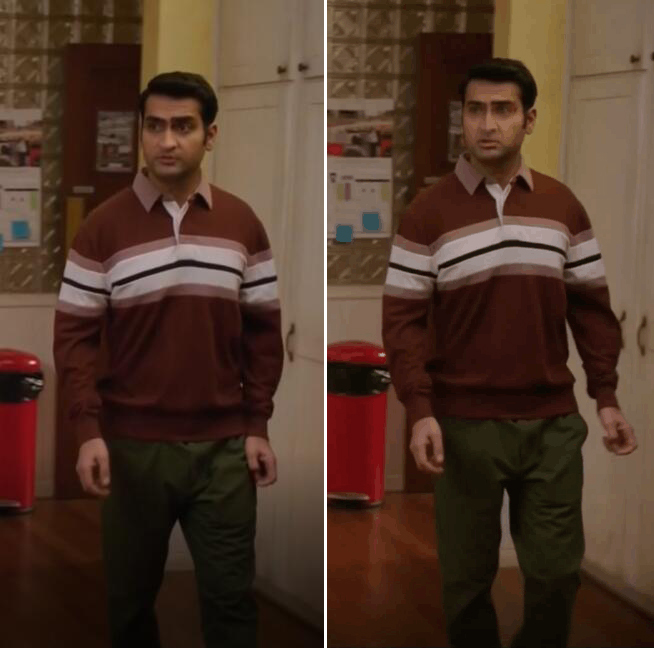【部分原创】python实现视频内的face swap(换脸)
1.准备工作,按博主的环境为准
Python 3.5
Opencv 3
Tensorflow 1.3.1
Keras 2
cudnn和CUDA,如果你的GPU足够厉害并且支持的话,可以选择安装
那就先安装起来,有兴趣的朋友给我个暗示,好让我有动力写下去,想实现整套的功能还是有点复杂的
第一部分,数据采集,及视频内人物脸
import cv2 save_path = 'your save path'
cascade = cv2.CascadeClassifier('haarcascade_frontalface_alt.xml path')
cap = cv2.VideoCapture('your video path')
i = 0
while True:
ret,frame = cap.read()
gray = cv2.cvtColor(frame,cv2.COLOR_BGR2GRAY)
rect = cascade.detectMultiScale(gray,scaleFactor=1.3,minNeighbors=9,minSize=(50,50),flags = cv2.CASCADE_SCALE_IMAGE)
print ("rect",rect)
if not rect is ():
for x,y,z,w in rect:
roiImg = frame[y:y+w,x:x+z]
cv2.imwrite(save_path+str(i)+'.jpg',roiImg)
cv2.rectangle(frame,(x,y),(x+z,y+w),(0,0,255),2)
i +=1
cv2.imshow('frame',frame)
if cv2.waitKey(1) &0xFF == ord('q'):
break
cap.release()
cv2.destroyAllWindows()
第二部分,国外大神开源代码,用于模型训练
import cv2
import numpy from utils import get_image_paths, load_images, stack_images
from training_data import get_training_data from model import autoencoder_A
from model import autoencoder_B
from model import encoder, decoder_A, decoder_B try:
encoder .load_weights( "models/encoder.h5" )
decoder_A.load_weights( "models/decoder_A.h5" )
decoder_B.load_weights( "models/decoder_B.h5" )
except:
pass def save_model_weights():
encoder .save_weights( "models/encoder.h5" )
decoder_A.save_weights( "models/decoder_A.h5" )
decoder_B.save_weights( "models/decoder_B.h5" )
print( "save model weights" ) images_A = get_image_paths( "data/trump" )
images_B = get_image_paths( "data/cage" )
images_A = load_images( images_A ) / 255.0
images_B = load_images( images_B ) / 255.0 images_A += images_B.mean( axis=(0,1,2) ) - images_A.mean( axis=(0,1,2) ) print( "press 'q' to stop training and save model" ) for epoch in range(1000000):
batch_size = 64
warped_A, target_A = get_training_data( images_A, batch_size )
warped_B, target_B = get_training_data( images_B, batch_size ) loss_A = autoencoder_A.train_on_batch( warped_A, target_A )
loss_B = autoencoder_B.train_on_batch( warped_B, target_B )
print( loss_A, loss_B ) if epoch % 100 == 0:
save_model_weights()
test_A = target_A[0:14]
test_B = target_B[0:14] figure_A = numpy.stack([
test_A,
autoencoder_A.predict( test_A ),
autoencoder_B.predict( test_A ),
], axis=1 )
figure_B = numpy.stack([
test_B,
autoencoder_B.predict( test_B ),
autoencoder_A.predict( test_B ),
], axis=1 ) figure = numpy.concatenate( [ figure_A, figure_B ], axis=0 )
figure = figure.reshape( (4,7) + figure.shape[1:] )
figure = stack_images( figure ) figure = numpy.clip( figure * 255, 0, 255 ).astype('uint8') cv2.imshow( "", figure )
key = cv2.waitKey(1)
if key == ord('q'):
save_model_weights()
exit()
第三部分,国外大神开源代码,人脸输出
import cv2
import numpy
from pathlib import Path from utils import get_image_paths from model import autoencoder_A
from model import autoencoder_B
from model import encoder, decoder_A, decoder_B encoder .load_weights( "models/encoder.h5" )
decoder_A.load_weights( "models/decoder_A.h5" )
decoder_B.load_weights( "models/decoder_B.h5" ) images_A = get_image_paths( "data/trump" )
images_B = get_image_paths( "data/cage" ) def convert_one_image( autoencoder, image ):
assert image.shape == (256,256,3)
crop = slice(48,208)
face = image[crop,crop]
face = cv2.resize( face, (64,64) )
face = numpy.expand_dims( face, 0 )
new_face = autoencoder.predict( face / 255.0 )[0]
new_face = numpy.clip( new_face * 255, 0, 255 ).astype( image.dtype )
new_face = cv2.resize( new_face, (160,160) )
new_image = image.copy()
new_image[crop,crop] = new_face
return new_image output_dir = Path( 'output' )
output_dir.mkdir( parents=True, exist_ok=True ) for fn in images_A:
image = cv2.imread(fn)
new_image = convert_one_image( autoencoder_B, image )
output_file = output_dir / Path(fn).name
cv2.imwrite( str(output_file), new_image )
第四部分,人脸替换
#import necessary libraries
import cv2
import glob as gb
# import numpy #capture video from the webcam
cap = cv2.VideoCapture('your video path')
fourcc = cv2.VideoWriter_fourcc(*'XVID')
out = cv2.VideoWriter('your output video path', fourcc, 20.0, (1920, 1080))
#load the face finder
face_cascade = cv2.CascadeClassifier('haarcascade_frontalface_alt.xml path') #load the face that will be swapped in
img_path = gb.glob("your image path") #start loop
for path in img_path:
face_img = cv2.imread(path)
while True:
ret, img = cap.read() # read image
gray = cv2.cvtColor(img, cv2.COLOR_BGR2GRAY)
faces = face_cascade.detectMultiScale(gray, 1.3, 3) # find faces
# for all the faces found in the frame
for (x, y, w, h) in faces:
# resize and blend the face to be swapped in
face = cv2.resize(face_img, (h, w), interpolation=cv2.INTER_CUBIC)
face = cv2.addWeighted(img[y:y + h, x:x + w], .5, face, .5, 1)
# swap faces
img[y:y + h, x:x + w] = face
out.write(img)
# show the image
cv2.imshow('img', img)
key = cv2.waitKey(1)
if key == ord('q'):
exit()
cap.release()
cv2.destroyAllWindows()
最后放一张训练一小时后的视频截图,用的是尼古拉斯凯奇的脸

【部分原创】python实现视频内的face swap(换脸)的更多相关文章
- 【原创】python实现视频内的face swap(换脸)
1.准备工作,按博主的环境为准 Python 3.5 Opencv 3 Tensorflow 1.3.1 Keras 2 cudnn和CUDA,如果你的GPU足够厉害并且支持的话,可以选择安装 那就先 ...
- [原创]使用python对视频/音频文件进行详细信息采集,并进行去重操作
[原创]使用python对视频/音频文件进行详细信息采集,并进行去重操作 转载请注明出处 一.关于为什么用pymediainfo以及pymediainfo的安装 使用python对视频/音频文件进行详 ...
- Python的常用内置函数介绍
Python的常用内置函数介绍 作者:尹正杰 版权声明:原创作品,谢绝转载!否则将追究法律责任. 一.取绝对值(abs) #!/usr/bin/env python #_*_coding:utf-8_ ...
- 零基础快速掌握Python系统管理视频课程【猎豹网校】
点击了解更多Python课程>>> 零基础快速掌握Python系统管理视频课程[猎豹网校] 课程目录 01.第01章 Python简介.mp4 02.第02章 IPython基础.m ...
- Python学习教程(Python学习视频_Python学些路线):Day06 函数和模块的使用
Python学习教程(Python学习视频_Python学些路线):函数和模块的使用 在讲解本章节的内容之前,我们先来研究一道数学题,请说出下面的方程有多少组正整数解. $$x_1 + x_2 + x ...
- [Python] 将视频转成ASCII符号形式、生成GIF图片
一.简要说明 简述:本文主要展示将视频转成ASCII符号形式展示出来,带音频. 运行环境:Win10/Python3.5. 主要模块: PIL.numpy.shutil. [PIL]: 图像处理 [n ...
- Python音视频开发:消除抖音短视频Logo和去电视台标
☞ ░ 前往老猿Python博文目录 ░ 一.引言 对于带Logo(如抖音Logo.电视台标)的视频,有三种方案进行Logo消除: 直接将对应区域用对应图像替换: 直接将对应区域模糊化: 通过变换将要 ...
- python常用数据类型内置方法介绍
熟练掌握python常用数据类型内置方法是每个初学者必须具备的内功. 下面介绍了python常用的集中数据类型及其方法,点开源代码,其中对主要方法都进行了中文注释. 一.整型 a = 100 a.xx ...
- python计算非内置数据类型占用内存
getsizeof的局限 python非内置数据类型的对象无法用sys.getsizeof()获得真实的大小,例: import networkx as nx import sys G = nx.Gr ...
随机推荐
- Java 实现策略(Strategy)模式
策略模式:行为型模式 将同一行为,不同的处理算法分别封装起来.让它们之间能够互相替换 1. 定义一个超类型接口,及 行为方法 2. 定义不同的实现类,实现该行为的 不同的算法 /** * 策略模式:针 ...
- 洛谷P3531 [POI2012]LIT-Letters
题目描述 Little Johnny has a very long surname. Yet he is not the only such person in his milieu. As it ...
- 调用C#版gdal库的一个注意事项
作者:朱金灿 来源:http://blog.csdn.net/clever101 在编译完C#版gdal库(x86平台)下,写了一个C#的控制台测试程序,出现下面的错误: 解决办法是将工程的目标平台设 ...
- HDU 2689 Tree
Tree Time Limit: 6000/2000 MS (Java/Others) Memory Limit: 32768/32768 K (Java/Others)Total Submis ...
- Spark scheduler
触发Spark scheduler的入口是调用者代码中的action操作,如groupByKey,first,take,foreach等操作.这些action操作最终会调用SparkContext.r ...
- C++中的纯虚函数
---恢复内容开始--- 在C++中的一种函数申明被称之为:纯虚函数(pure virtual function).它的申明格式如下 class CShape { public: ; }; 在什么情况 ...
- [置顶]
Docker学习总结(3)——Docker实战之入门以及Dockerfile(三)
应用镜像 csphere/wordpress:4.2 # cd docker-training/wordpress/ # ls -a . license.txt wp-config-sample.ph ...
- 47.Android 自己定义PopupWindow技巧
47.Android 自己定义PopupWindow技巧 Android 自己定义PopupWindow技巧 前言 PopupWindow的宽高 PopupWindow定位在下左位置 PopupWin ...
- JMS基础知识
JMS规范: jms的基本构件: 连接工厂(connectionFactory):客户用来创建连接的对象.比如:activeMQ提供的ActiveMQConnectionFactory. 连接(co ...
- js引入广告服务
var header = []; header[1] = { 'title' : '新浪开始进军微博大战', 'pic' : 'images/header1.png', 'link' : 'http: ...
